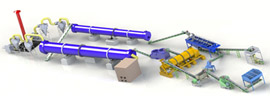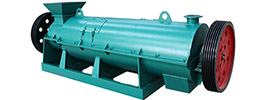The addition of microbial inoculants in organic fertilizer production requires combining raw material characteristics, fermentation processes, and inoculant types. Key steps include scientific proportioning, uniform mixing, and precise control of temperature and humidity to ensure inoculant activity and fermentation efficiency. Below are detailed methods and precautions:
I. Preparation Before Adding Inoculants
- Select Appropriate Inoculants
Choose inoculants based on raw material types (e.g., livestock manure, straw, kitchen waste) and fermentation goals (e.g., rapid heating, odor control, composting). Examples:
- Aerobic inoculants (e.g., Bacillus subtilis, yeast): Suitable for high-temperature aerobic fermentation to rapidly decompose organic matter and eliminate pathogens.
- Composite inoculants:ain multiple microorganisms and enzymes for synergistic fermentation of complex raw materials.
- Functional inoculants (e.g., phosphate-solubilizing, potassium-releasing bacteria): Used to produce bio-organic fertilizers with enhanced nutrient availability.
- Activate and Propagate Inoculants
- Activation: Mix inoculants with nutrient agents (e.g., brown sugar, wheat bran) at a 1:10 ratio. Add water to achieve 20%-25% moisture content, then ferment at 25-30°C for 24 hours to activate microbial colonies.
- Propagation: Mix activated inoculants with dry grass powder or straw at a 1:50 ratio, add water, and propagate to ensure uniform distribution.
II. Methods of Adding Inoculants
- Direct Addition Method
- Steps: Add activated inoculants at 0.1%-0.2% of the raw material weight directly into the mixture and blend thoroughly using a mixer.
- Applicable Scenarios: Suitable for raw materials with moderate moisture (50%-60%) and balanced carbon-to-nitrogen ratios (25:1-30:1).
- Layered Spraying Method
- Steps:
- Dilute inoculants to an appropriate concentration (e.g., 1:200-500).
- Layer raw materials in windrows or fermentation tanks, spraying the inoculant solution evenly between layers to ensure penetration.
- Cover with straw mats or plastic sheets for insulation and moisture retention.
- Applicable Scenarios: Ideal for low-moisture raw materials or when rapid fermentation initiation is needed (e.g., straw-based materials).
- Secondary Addition Method
- Steps:
- After initial fermentation, when temperatures drop below 40°C, add functional inoculants (e.g., phosphate-solubilizing bacteria, nitrogen-fixing bacteria).
- Mix thoroughly and continue fermentation for 7-15 days to enhance fertilizer efficacy.
- Applicable Scenarios: Used for producing bio-organic fertilizers or supplementing specific nutrients.
III. Key Control Parameters
- Temperature
- Heating Phase: Maintain temperatures above 55°C. Turn piles daily to promote microbial activity.
- High-Temperature Phase: Sustain 55-65°C for 7-15 days to eliminate pathogens and weed seeds.
- Cooling Phase: Stop turning when temperatures fall below 40°C to facilitate humus formation.
- Moisture
- Maintain 50%-60% moisture content throughout (squeeze test: forms a ball but breaks apart when dropped).
- Add water if moisture is insufficient; turn piles to reduce excess moisture.
- Oxygen
- Adjust porosity to 30%-50% via turning frequency to avoid anaerobic fermentation (which causes odors).
- pH
- Initial pH: 6.5-8.5. Adjust with lime (acidic materials) or superphosphate (alkaline materials).
IV. Precautions
- Prevent Inoculant Inactivation
- Avoid mixing with fungicides or disinfectants.
- Store inoculants in cool, dark places to prevent heat or freezing damage.
- Uniform Mixing
- Ensure thorough blending of inoculants with raw materials to avoid uneven concentrations.
- Phased Addition
- Select inoculant types based on fermentation stages (e.g., rapid-heating strains initially, functional strains later).
- Equipment Support
- Use turners, mixers, or other machinery to improve efficiency and reduce manual errors.
V. Typical Case Studies
- Livestock Manure + Straw Fermentation
- Raw Material Ratio: 60% chicken manure, 30% corn straw, 8% wheat bran, 2% inoculant.
- Inoculant Addition: Activate inoculants with wheat bran, then spray evenly between layers in windrows (1.2-1.5 m high, 2-3 m wide).
- Fermentation Cycle: 3 days heating, 15 days high-temperature, 7 days cooling (total: 25 days).
- Kitchen Waste + Garden Waste Fermentation
- Raw Material Ratio: 50% kitchen waste, 40% garden trimmings, 8% rice bran, 2% EM inoculant.
- Inoculant Addition: Dilute EM inoculant and spray onto raw materials. Cover with plastic sheets and turn every 5-7 days.
- Fermentation Cycle: 30 days total, with humus content exceeding 35% post-fermentation.
 Send us a Email
Send us a Email Wulong Industrial Cluster
Wulong Industrial Cluster Have any question?
Have any question?



















